|
 |
Ferdinand bol
|
|
Dutch Baroque Era Painter, 1616-1680
Dutch painter and draughtsman. He was a pupil and prominent follower of Rembrandt in Amsterdam. His reputation and fame are based on his history paintings, which, though successful at the time, |
 |
Felix Ziem
|
|
French Painter, 1821-1911
was a French painter in the style of the Barbizon School. Born Felix-Francois Georges Philibert Ziem in Beaune in the Côte d'Or departement of the Burgundy region of France, his mother was a native of Burgundy who married a Croatian immigrant. Originally, Ziem planned to be an architect and studied at the School of Architecture in Dijon, and for a time worked as an architect. Painting developed from a hobby to a career following an 1841 visit to Italy where he fell in love with the city of Venice, a place that would become the source for many of his works. Apart from Venetian scenes, he also painted many still lifes, portraits and landscapes from a variety of places including Constantinople, Martigues, Cagnes-sur-Mer and his native Burgundy. Ziem's works were first exhibited in 1849 at the Paris Salon and remained a regular exhibitor there for many years. Part of the Barbizon school, he also traveled extensively throughout Europe and in 1860 moved to Montmartre, the artistic quarter of the city of Paris. Financially successful, he was known to assist struggling young artists. In 1857, the government of France recognized his contribution to the art world by making him a Chevalier of the Legion of Honor. |
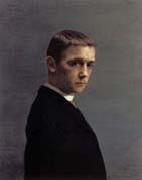 |
Felix Vallotton
|
|
1865-1925was a Swiss painter and printmaker associated with Les Nabis. He was an important figure in the development of the modern woodcut. He was born into a conservative middle class family in Lausanne, and there he attended College Cantonal, graduating with a degree in classical studies in 1882. In that year he moved to Paris to study art under Jules Joseph Lefebvre and Gustave Boulanger at the Academie Julian. He spent many hours in the Louvre, where he greatly admired the works of Holbein, Derer and Ingres; these artists would remain exemplars for Vallotton throughout his life.[1] His earliest paintings, such as the Ingresque Portrait of Monsieur Ursenbach (1885), are firmly rooted in the academic tradition, and his self portrait of 1885 (seen at right) received an honorable mention at the Salon des artistes français in 1886. During the following decade Vallotton painted, wrote art criticism and made a number of prints. In 1891 he executed his first woodcut, a portrait of Paul Verlaine. The many woodcuts he produced during the 1890s were widely disseminated in periodicals and books in Europe as well as in the United States, and were recognized as radically innovative in printmaking. They established Vallotton as a leader in the revival of true woodcut as an artistic medium; in the western world, the relief print, in the form of commercial wood engraving, had long been mainly utilized unimaginatively as a medium for the reproduction of drawn or painted images and, latterly, photographs. Vallotton's starkly reductive woodcut style features large masses of undifferentiated black and areas of unmodulated white. While emphasizing outline and flat patterns, Vallotton generally made no use of the gradations and modeling traditionally produced by hatching. The influences of post-Impressionism, symbolism and the Japanese woodcut are apparent; a large exhibition of ukiyo-e prints had been presented at the École des Beaux-Arts in 1890, and Vallotton, like many artists of his era an enthusiast of Japonism, collected these prints. He depicted street crowds and demonstrations including several scenes of police attacking anarchists bathing women, portrait heads, and other subjects which he treated with a sardonic humor. His graphic art reached its highest development in Intimit's (Intimacies), a series of ten interiors published in 1898 by the Revue Blanche, which deal with tension between men and women. Vallotton's prints have been suggested as a significant influence on the graphic art of Edvard Munch, Aubrey Beardsley, and Ernst Ludwig Kirchner .By 1892 he was affiliated with Les Nabis, a group of young artists that included Pierre Bonnard, Ker-Xavier Roussel, Maurice Denis, and Edouard Vuillard, with whom Vallotton was to form a lifelong friendship. During the 1890s, when Vallotton was closely allied with the avant-garde, his paintings reflected the style of his woodcuts, with flat areas of color, hard edges, and simplification of detail. |
 |
felix mendelssohn
|
|
Period: Romantic (1820-1869)
Country: Germany
Born: February 03, 1809 in Hamburg, Germany
Died: November 04, 1847 in Leipzig, Germany |
 |
Felix Maria Diogg
|
|
(b Andermatt, 1 July 1762; d Rapperswil, Schwyz, 19 Feb 1834). Swiss painter. From 1782 he was a pupil of Johann Melchior Wyrsch in Besanion, under whom he developed the essential aspects of his portrait style. He also studied further in Rome and Naples from 1786 to 1788. He was capable of executing bright, incisive portraits in the manner of Angelica Kauffman, as in Portrait of an Artist or psychological studies, best seen in Ulysses von Salis-Marschlins. Several of his group portraits, such as the Esslinger Family, show the influence of Italian and British painting, with which he seemed to be familiar. He was a friend of Johann Kaspar Lavater, discoursed with Goethe and enjoyed the company of the Swiss historian Johannes von Miller (1752-1809), whose portrait he painted. His portraits are generally bust-length types set against a solid, dark background. This format was favoured by his Swiss clientele and is seen in Burgomaster Heinrich Krauer (1799; Lucerne, Kstmus.), which also reveals the dignified wooden pose frequently selected by his models. His direct, fashionable treatment of the sitter attracted a wide range of clients from all levels of society. He seemed to be as much at ease painting the Empress of Russia, Yelisaveta Alekseyevna (1814; Karlsruhe, Staatl. Ksthalle) as he was portraying the bourgeoisie of central Switzerland. |
 |
Felix Esterl
|
|
(1894 -1931 ) - Painter
painted Still life with fruits, foliage plants and jug in |
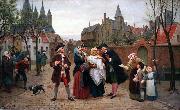 |
Felix de Vigne
|
|
(16 March 1806 - 5 December 1862) was a Belgian painter.
De Vinge was a history painter, engraver, art historian, and instructor at the Royal Academy of Fine Arts (Ghent). In 1847 he published Recherches historiques sur les costumes civils et militaires, an illustrated compendium of the flags, shields and costumes of medieval guilds and military groups.
He was the brother of sculptor Pieter De Vigne (1812-1877), father of Brussels architect Edmond De Vinge (1841-1918), and the stepfather of painter Jules Breton.
|
 |
Felix Auvray
|
|
a French historical painter, was born at Cambrai in 1800. He was a pupil of Momal in Valenciennes, and afterwards of Gros in Paris. He exhibited in 1824, 'St. Louis a Prisoner,' and in 1827, 'Gautier de Châtillon defending St. Louis against the Saracens,' now in the Museum of Cambrai; 'St. Paul at Athens,' &c. He died in 1833, in his native city.
|
 |
Felix Vallotton
|
|
French
1865-1925
Felix Vallotton Gallery
Swiss woodcut artist and painter. Associated with the Nabis, he worked in Paris. Vallotton rejuvenated the woodcut medium as a creative technique. His boldly cut designs, conceived as arrangements in black and white, depict Parisian society with wit and intelligence. A painting, Swiss Landscape, is in the Lyman Allyn Museum, New London, |
 |
Felicien Rops
|
|
Belgian Symbolist Engraver, 1833-1898
was a Belgian artist, and printmaker in etching and aquatint. Rops was born in Namur in 1833, and was educated at the University of Brussels. Rops's forte was drawing more than painting in oils; he first won fame as a caricaturist. He met Charles Baudelaire towards the end of Baudelaire's life in 1864, and Baudelaire left an impression upon him that lasted until the end of his days. Rops created the frontispiece for Baudelaire's Les Épaves, a selection of poems from Les Fleurs du mal that had been censored in France, and which therefore were published in Belgium. Rops's association with Baudelaire and with the art he represented won his work the admiration of many other writers, including Theophile Gautier, Alfred de Musset, St phane Mallarm, Jules Barbey d'Aurevilly, and Josephin Peladan. He was closely associated with the literary movement of Symbolism and Decadence. Like the works of the authors whose poetry he illustrated, his work tends to mingle sex, death, and Satanic images. |
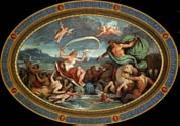 |
Felice Giani
|
|
Italian Neoclassical Painter, ca.1758-1823,Italian painter and draughtsman. He was a prolific painter who, with a team of artists and craftsmen, decorated palaces and public buildings in Rome, Venice, many cities in Emilia Romagna (especially Faenza), and in France. He worked in a distinctive Neo-classical style, creating sumptuous, richly coloured rooms, the paintings on walls and ceilings being surrounded with a wealth of antique ornament. Despite the turbulent era of revolution and war (1789-1815) he never lacked commissions, for which he chose subjects from the literature and history of Greece and Rome that were symbolic both for him and for his patrons. He was a prodigiously talented draughtsman, who drew constantly, |
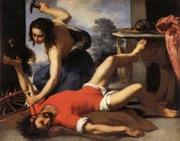 |
Felice Ficherelli
|
|
Italian painter , b. 1603, San Gimignano, d. 1660, Firenze
Firenze,Italian painter. His most original works were easel pictures, for private collectors, often of cruel and violent subjects, which he interpreted with a morbid sensuality and ambiguous tenderness. He was brought to Florence when very young by the collector Conte Alberto Bardi (d 1632), who arranged for him to study with Jacopo da Empoli and to copy works by Andrea del Sarto. Ficherelli's clear compositions and luminous drapery, which remain evident throughout his career, reflect this training. In the early 1630s he was attracted by the delicate sfumato effects of Francesco Furini and developed a style close to that of Cecco Bravo; his works of this period include the Sacrifice of Isaac (Florence, priv. col., for illustration see Gregori, 1968, p. 26) and the Martyrdom of St Agatha (priv. col., see Cantelli, fig. 338). There followed in the late 1630s Tarquin and Lucretia, which is known in several versions (e.g. Rome, Accad. N. S Luca), the theatrical Julia Receiving the Bloodstained Garments of Pompey (Genoa, priv. col., see 1986 exh. cat., pl. 1.208), an Allegory of Patience (Florence, Bigongiari priv. col., see Gregori, 1974, fig. 23) and Antiochus and Stratonica (Auckland, C.A.G.). |
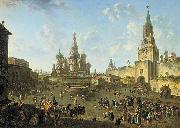 |
Fedor Yakovlevich Alekseev
|
|
Fedor Yakovlevich Alekseev Russian: (c. 1753 - November 23, 1824) was an early Russian painter of landscape art.
After training in the Saint Petersburg Imperial Academy of Arts, he spent three years in Venice studying the works of famous French and Italian landscape painters.
Returning to Saint Petersburg to work, his popularity grew over time. In 1800, Emperor Paul of Russia commissioned a series of paintings of Moscow from him.
|
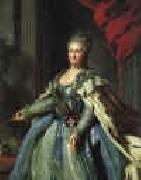 |
Fedor Rokotov
|
|
Russian Painter, ca.1735-1808
Fyodor Stepanovich Rokotov (Fedor Rokotov) (Russian: ?????????? ??????????́?????????? ????́??????????) (1736?C1809) was a distinguished Russian painter who specialized in portraits.
Fyodor Rokotov was born into a family of peasant serfs, belonging to the Repnins. Much in his biography is obscure. He studied art in Saint Petersburg Academy of Arts. After buying back his freedom in the end of 1750s he became established as a fashionable painter.
In 1765, Rokotov was elected an Academician, but he did not work as a professor in the Academy long, because it interfered with his painting. He returned to Moscow in 1765, where he lived for the rest of his life. He had a lot of commissions there, becoming one of the best portrait painters of his time.
Among his best-known portraits are Portrait of Alexandra Struyskaya (1772), sometimes called the Russian Mona Lisa and admittedly the most celebrated piece of the 18th-century Russian painting; Portrait of Countess Elisabeth Santi (1785), and Lady in a Pink Dress (1770s, illustration, right).
Rokotov avoided painting formal portraits with lots of adornments and decorations. Instead he was one of the first Russian painters advancing a psychological portrait with attention to optical and atmospheric effects. |
 |
Fedor Alekseev
|
|
(c. 1753 ?C November 23, 1824) was an early Russian painter of landscape art.
After training in the Saint Petersburg Imperial Academy of Arts, he spent three years in Venice studying the works of famous French and Italian landscape painters.
Returning to Saint Petersburg to work, his popularity grew over time. In 1800, Emperor Paul of Russia commissioned a series of paintings of Moscow from him.
|
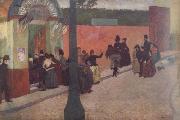 |
Federico zandomeneghi
|
|
Italian Painter, 1841-1917
.Italian painter. His father Pietro and grandfather Luigi tried to interest him in the plastic arts, but from a very early age he showed a stronger inclination for painting. Zandomeneghi soon rebelled against their teachings, and by 1856 he was attending the Accademia di Belle Arti in Venice, studying under the painters Michelangelo Grigoletti (1801-70) and Pompeo Molmenti (1819-94). As a Venetian he was born an Austrian subject, and, to escape conscription, he fled his city in 1859 and went to Pavia, where he enrolled at the university. In the following year he followed Garibaldi in the Expedition of the Thousand; afterwards, having been convicted of desertion and therefore unable to return to Venice, he went to Florence, where he remained from 1862 to 1866. This period was essential for his artistic development. In Tuscany he frequented the Florentine painters known as the Macchiaioli, with some of whom he took part in the Third Italian War of Independence (1866). Zandomeneghi formed a strong friendship with Telemaco Signorini and Diego Martelli, with whom he corresponded frequently for the rest of his life. In this period he painted the Palazzo Pretorio of Florence |
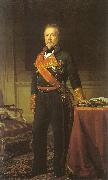 |
Federico de Madrazo y Kuntz
|
|
1815-1894
Spanish
Federico de Madrazo y Kuntz Gallery
Born in Rome, he was the son of the painter Madrazo y Agudo (1781-1859), and received his first instruction from his father. While still attending the classes at the Royal Academy of San Fernando, he painted his first picture, The Resurrection of Christ (1829), which was purchased by Queen Christina. Not long afterwards he painted Achilles in his Tent, and subsequently presented to the Academy The Continence of Scipio, which secured him admission as a member "for merit".
While decorating the palace of Vista Alegre he took up portraiture. In 1852 he went to Paris, where he studied under Franz Winterhalter, and painted portraits of Baron Taylor and Ingres. In 1837 he was commissioned to produce a picture for the gallery at Versailles, and painted "Godfrey de Bouillon proclaimed King of Jerusalem". The artist then went to Rome, where he worked at various subjects, sacred and profane. Then he painted Maria Christina in the Dress of a Nun by the Bedside of Ferdinand III (1843), Queen Isabella, The Duchess of Medina-Coeli, and The Countess de Vilches (1845-1847), besides a number of portraits of the Spanish aristocracy, some of which were sent to the exhibition of 1855.
He received the Legion of Honour in 1846. He was made a corresponding member of the Paris Academy of Fine Arts on 10 December 1853, and in 1873, on the death of Schnorr, the painter, he was chosen foreign member. After his father's death he succeeded him as director of the Museo del Prado and president of the Academy of San Fernando. He originated in Spain the production of art reviews and journals, such as El Artiste, El Renacimiento, and El Semanario pintoresco. He died at Madrid in 1894.
|
 |
Fede Galizia
|
|
(1578 - 1630) was an Italian Renaissance painter, a pioneer of the still life genre.
Fede Gallizi, better known as Galizia, was born in Milan in 1578. Her father, Nunzio Galizia, also a painter of miniatures, had moved to Milan from Trento. Fede (whose name means "faith") learned to paint from him. By the age of twelve, she was sufficiently accomplished as an artist to be mentioned by Gian Paolo Lomazzo, a painter and art theorist friend of her father, who wrote, "This girl dedicates herself to imitate our most extraordinary art."
At a young age, Fede was already an established portrait painter handling many commissioned works. Perhaps it was her father's influence as a miniaturist that led to Fede's attention to detail in her portraits. Her treatment of jewels and clothing made her a very desirable portrait painter. She was often commissioned to paint religious and secular themes as well. Several of her paintings based on the deuterocanonical story of Judith and Holofernes, a popular theme in art of the period, survive in private collections. Perhaps her earliest was Judith and Her Handmaiden painted in 1596 which is now in Sarasota Florida at the Ringling Museum of Art. She also created miniatures and altarpieces for convents. |
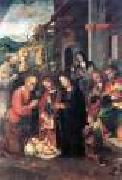 |
FASOLO, Bernardino
|
|
Italian painter, Genovese school (b. ca. 1489, Pavia, d. after 1526, Genova) |
 |
FARINATI, Paolo
|
|
Italian painter, Veronese school (b. 1524, Verona, d. 1606, Verona)
Italian painter and draughtsman. He was the son of a painter, Giambattista, but probably trained in the workshop of Nicola Giolfino (Vasari). His earliest documented painting, St Martin and the Beggar (1552; Mantua Cathedral), was commissioned by Cardinal Ercole Gonzaga along with works by Battista dell'Angolo del Moro, Veronese and Domenico Brusasorci for Mantua Cathedral, newly restored by Giulio Romano. As is evident in his chiaroscuro and figure types, Farinati had absorbed certain Mannerist influences from the frescoes of scenes from the Life of the Virgin (1534) in the choir of Verona Cathedral, executed by Francesco Torbido to Giulio's design. Giolfino's eccentric style would also have encouraged Farinati to emphasize line over colour and to restrict his palette to rather opaque greys, browns, mauve and rust. His two-canvas Massacre of the Innocents (1556; Verona, S Maria in Organo) displays the muscular figures, sharp foreshortenings and posed attitudes of Mannerism and has a more polished finish than his earlier work. Its strong, plastic qualities are also evident in Christ Walking on the Water and the Supper of St Gregory (1558) in the choir of the same church. |
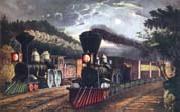 |
Fanny Palmer
|
|
One of the premier artists and stone lithographers .
American , 1812-1876
|
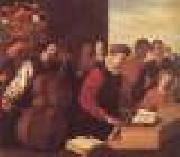 |
FALCONE, Aniello
|
|
Italian painter, Naples school (b. 1607, Napoli, d. 1656, Napoli).
Italian painter and draughtsman. He trained briefly with Jusepe de Ribera, the Caravaggesque Spanish painter. He quickly won fame as a specialist in scenes of battle, and his contemporaries nicknamed him the 'oracle' of this genre. Falcone created the 'battle scene without a hero' (Saxl): he showed the battle as a brutal, confused struggle between anonymous troops, without heroes, without defeats and without particular historical incidents. The Battle between Turks and Christians (1621; Paris, Louvre; see fig.) is one of the earliest. The frieze-like composition is elaborately structured, yet the picture is rich in intensely naturalistic, vividly coloured details of armour and weapons and precisely observed expressions of anger and pain. The famous dealer and collector Gaspar Roomer and other Neapolitan collectors commissioned many battle pictures from him, and these were soon introduced throughout Europe. He was especially favoured by Ferrante Spinelli, Prince of Tarsia, who gave Falcone a residence in his palace after 1651. |
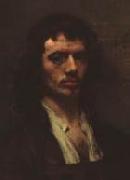 |
FABRITIUS, Carel
|
|
Dutch Baroque Era Painter, 1622-1654
Painter. His oeuvre consists of a scant dozen paintings, since research has rigorously discounted many previously attributed works. These few paintings, however, document the painter's unique development within his brief 12-year career. He is often mentioned as being the link between Rembrandt and the Delft school, particularly Pieter de Hooch and Jan Vermeer, whose depiction of light owes much to Fabritius's late works in which his use of cool silvery colours to define forms in space marks a radical departure |
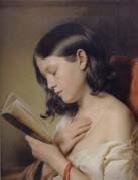 |
EYBL, Franz
|
|
1805, Vienna - 1880, Vienna,Austrian painter and lithographer. He entered the Vienna Akademie at the age of ten, studying sculpture under Josef Klieber and landscape painting (1817-20) with Joseph Messmer (1780-1845), from whom he also learnt the new technique of lithography. He then spent three years with Johann Baptist Lampi (i) and Franz Caucig (1762-1828), drawing after antique statues and casts. He studied history painting (1823-8), during which period he came under the influence of Johann Peter Krafft, who introduced him to the principles of realism, suggesting that he work directly from nature and reflect contemporary, everyday subject-matter in his painting. Together with Josef Danhauser and Matthias Ranftl (1805-54), Eybl was among the most significant followers of Krafft's ideas, |
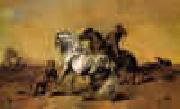 |
Eugene Fromentin
|
|
1820-1876
He was born in La Rochelle. After leaving school he studied for some years under Louis Cabat, the landscape painter. Fromentin was one of the earliest pictorial interpreters of Algeria, having been able, while quite young, to visit the land and people that suggested the subjects of most of his works, and to store his memory as well as his portfolio with the picturesque and characteristic details of North African life. In 1849 he obtained a medal of the second class.
In 1852 he paid a second visit to Algeria, accompanying an archaeological mission, and then completed that minute study of the scenery of the country and of the habits of its people which enabled him to give to his after-work the realistic accuracy that comes from intimate knowledge. In a certain sense his works are contributions to ethnological science as much as they are works of art. |
 |
Eugene Fichel
|
|
(30 August 1826 Paris - 2 February 1895 Paris) was a French painter.
He entered the École des Beaux-Arts in 1844 and became a pupil of Hippolyte Delaroche, but painted very much more under the inspiration of Jean-Louis-Ernest Meissonier, whose exquisite handling is suggested in numerous small canvases of his which by their refined technique and vivid action recall the characteristic intensity and directness of composition which belong to the painter of eFriedland.e Along with great care in finish, Fichel's canvases also exhibit an archæological exactness, and a kind of delicate humor. His first work of importance was exhibited in 1850, eHarvey Demonstrating the Circulation of the Blood to Charles I.e He was a chevalier of the Legion of Honor and, in 1857, received a medal for his painting in the Salon of that year. He exhibited a canvas every year at the Salon, up to a few years before his death.
|
 |
Ernst Fries
|
|
(22 June 1801 Heidelberg - 11 October 1833 Karlsruhe) was a German painter.
Fries was a pupil of Karl Kuntz at Karlsruhe, and afterwards studied in Munich and in Italy. Examples of his work are: eA View of Tivoli, Sorrento and the House of Tasso, The Waterfall of Liris at Isola di Sora, The Castle of Massa, and A View of Heidelberg.
|
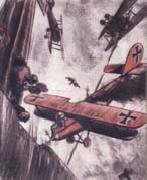 |
Ernest Fuhr
|
|
A popular illustrator of the period and this is classic patriotic art . 1874-1933
|
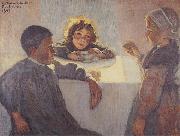 |
Eric Forbes-Robertson
|
|
(1865-1935).
a figure and landscape painter
a figure and landscape painter.was a Scottish painter of landscapes, flowers, and foliage, with children. He was a cousin of James Hornell. He was born in Australia, of Scottish parents, and he was brought up and lived practically all his life in Scotland, at Kirkcudbright. He studied for three years at the art school at Edinburgh, and for two years at Antwerp under Professor Verlat. Returning from Antwerp in 1885, he met George Henry and associated himself with the Glasgow School. Hornel and Henry collaborated upon "The Druids Bringing In The Mistletoe" (1890), a procession of priests bringing in the sacred mistletoe, gorgeous with polychrome and gold. The two worked side by side to achieve decorative splendor of color, Hornel boldly and freely employing texture effects produced by loading and scraping, roughening, smoothing, and staining. In 1893-94 the two artists spent a year and a half in Japan, where Hornel learned much about decorative design and spacing. Towards the close of the nineties his colors, while preserving their glow and richness, became more refined and more atmospheric, and his drawing more naturalistic, combining sensuous appeal with emotional and poetic significance. In 1901 he declined election to the Royal Scottish Academy. In 1901 he acquired Broughton House, a townhouse and garden in Kirkcudbright, which was his main residence for the rest of his life. |
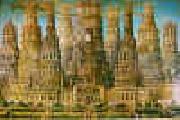 |
Erastus Salisbury Field
|
|
1805-1900
American painter. He studied with Samuel F. B. Morse in New York during the winter of 1824-5. On his return to the rural isolation of Leverett, MA, he painted his earliest known work, the portrait of his grandmother Elizabeth Billings Ashley (Springfield, MA, Mus. F.A.). His career as an itinerant portrait painter began in 1826, most of his commissions coming through a network of family associations in western Massachusetts and Connecticut. The portraits of 1836-40 are considered his best. From 1841 he lived mainly in New York, where he expanded his subject-matter to include landscapes and American history pictures. There he presumably studied photography, for on his return to Massachusetts he advertised himself as a daguerreotypist. His few portraits painted after 1841 are copied from his own photographs and lack the expressive characterization and decorative power of his earlier work. From 1865 to 1885 his paintings were based primarily on biblical and patriotic themes. The Historical Monument of the American Republic (1867-88; Springfield, MA, Mus. F.A.) stands alone in American folk art in size (2.82*3.89 m), scope and imaginative vision. Inspired by plans for a national celebration of the centennial of the USA in 1876, Field painted an architectural fantasy of eight towers linked by railway bridges and trains at the tops, with the history of the USA in low-relief sculpture on the exterior surfaces of the towers. Field added two more towers to the painting in 1888 and thereafter retired. |
|

